I understand that standard deviation is the measurement of the consistency and reliability for a bullet to travel within a given fps range. My question is what is an acceptable sd for many long range shooters? For instance I shot a 10 shot group with a standard deviation of 9. Is that good? If not what can I do at the reloading bench to improve.
Join the Hide community
Get access to live stream, lessons, the post exchange, and chat with other snipers.
Register
Download Gravity Ballistics
Get help to accurately calculate and scope your sniper rifle using real shooting data.

Install the app
How to install the app on iOS
Follow along with the video below to see how to install our site as a web app on your home screen.
Note: This feature may not be available in some browsers.
-
The Shot You’ll Never Forget Giveaway - Enter To Win A Barrel From Rifle Barrel Blanks!
Tell us about the best or most memorable shot you’ve ever taken. Contest ends June 13th and remember: subscribe for a better chance of winning!
Join contest Subscribe
You are using an out of date browser. It may not display this or other websites correctly.
You should upgrade or use an alternative browser.
You should upgrade or use an alternative browser.
Standard deviation
- Thread starter Aimsmall55
- Start date
Re: Standard deviation
I think that is good. The problem I have is given the inherent inaccuracy of a chrony, how can we be sure these numbers are correct?
I think that is good. The problem I have is given the inherent inaccuracy of a chrony, how can we be sure these numbers are correct?
Re: Standard deviation
As Chanonry says...the inherent accuracy of amateur grade chronos is around 13 to 14 FPS plus or minus. If you get a max spread of 13 you are within whatever the chrono can do. Instead of 10 rounds, do 30 to 50 and see where your spread and SD are. That will be more statistically valid. JMHO
As Chanonry says...the inherent accuracy of amateur grade chronos is around 13 to 14 FPS plus or minus. If you get a max spread of 13 you are within whatever the chrono can do. Instead of 10 rounds, do 30 to 50 and see where your spread and SD are. That will be more statistically valid. JMHO
Re: Standard deviation
I slept through most of stats 133 in college and somehow skirted by with a B (gotta love cram sessions), but I think I remember hearing something about needing to have at least a sampling of 30 for anything to be statistically valid. While 10 shots is good, if you can chrono 30 or so you'll have a much more accurate result.
I also remember a quick way to interpret mean/avg, SD, spread, etc. and will relate it to shooting. I'll do my best to avoid statistical terms and keep it in shooters/layman's terms. Again, I'm recalling information mostly long forgotten, so if anyone here is actually a guru here feel free to chime in and correct me.
the mean is the easiest - the sum of all of your shot fps (2600+2602+2596... etc.) divided by the number of shots. This provides you the mean/average.
Without getting into anything very technical, the standard deviation shows you how close to the average your samples are. Obviously the smaller the standard deviation, the more consistent your velocites are in this case. For instance, say you had a mean/avg velocity of 2600 after 30 shots to make things easy, and your standard deviation was 5. If you took 30 shots, about 68% of these shots (roughly 20 out of the 30) will statistically fall between 2595 and 2605 which is pretty good. 95% of these (or roughly 28/30) would fall between 2590 and 2610.
I *think* that's correct... either way, if you're showing a standard deviation of 9, that's still very good. I'd be happy knowing 2/3s of my shots were going to fall within +/- 18fps of my average.
I slept through most of stats 133 in college and somehow skirted by with a B (gotta love cram sessions), but I think I remember hearing something about needing to have at least a sampling of 30 for anything to be statistically valid. While 10 shots is good, if you can chrono 30 or so you'll have a much more accurate result.
I also remember a quick way to interpret mean/avg, SD, spread, etc. and will relate it to shooting. I'll do my best to avoid statistical terms and keep it in shooters/layman's terms. Again, I'm recalling information mostly long forgotten, so if anyone here is actually a guru here feel free to chime in and correct me.
the mean is the easiest - the sum of all of your shot fps (2600+2602+2596... etc.) divided by the number of shots. This provides you the mean/average.
Without getting into anything very technical, the standard deviation shows you how close to the average your samples are. Obviously the smaller the standard deviation, the more consistent your velocites are in this case. For instance, say you had a mean/avg velocity of 2600 after 30 shots to make things easy, and your standard deviation was 5. If you took 30 shots, about 68% of these shots (roughly 20 out of the 30) will statistically fall between 2595 and 2605 which is pretty good. 95% of these (or roughly 28/30) would fall between 2590 and 2610.
I *think* that's correct... either way, if you're showing a standard deviation of 9, that's still very good. I'd be happy knowing 2/3s of my shots were going to fall within +/- 18fps of my average.
Re: Standard deviation
I don't think SD is worth squat. Here's why:
You could have a couple rounds with 100 fps difference from the mean. If the rest of your rounds were all close in terms of velocity, it would show a small SD.
You also need to know where your chrony ends its first standard deviation. Is it 2/3rds? 3/4ths on the bell curve?
I find extreme spread as the only useful measurement. I want to know from low to high what my spread is. That's how you eliminate flyers.
After all is said and done, if it prints an "X" I don't care what the chrony says. It's a keeper.
I don't think SD is worth squat. Here's why:
You could have a couple rounds with 100 fps difference from the mean. If the rest of your rounds were all close in terms of velocity, it would show a small SD.
You also need to know where your chrony ends its first standard deviation. Is it 2/3rds? 3/4ths on the bell curve?
I find extreme spread as the only useful measurement. I want to know from low to high what my spread is. That's how you eliminate flyers.
After all is said and done, if it prints an "X" I don't care what the chrony says. It's a keeper.
Re: Standard deviation
I could not agree more with Himaster.I want to shoot a 20 shot 600-800 yd match and not have that one flyer ruin my whole day. Tailoring my load so as to keep the extreme spread in the single digits has been the solution. The SD does not address the "one flyer" I might add that keeping ES in the single digits is no easy trick
I could not agree more with Himaster.I want to shoot a 20 shot 600-800 yd match and not have that one flyer ruin my whole day. Tailoring my load so as to keep the extreme spread in the single digits has been the solution. The SD does not address the "one flyer" I might add that keeping ES in the single digits is no easy trick
Re: Standard deviation
<div class="ubbcode-block"><div class="ubbcode-header">Originally Posted By: himaster</div><div class="ubbcode-body">You could have a couple rounds with 100 fps difference from the mean. If the rest of your rounds were all close in terms of velocity, it would show a small SD.
</div></div>
ummmmmmmm... no
http://easycalculation.com/statistics/standard-deviation.php
(99) 2800s
(1) 2700
SD: 14
<div class="ubbcode-block"><div class="ubbcode-header">Originally Posted By: himaster</div><div class="ubbcode-body">You also need to know where your chrony ends its first standard deviation. Is it 2/3rds? 3/4ths on the bell curve? </div></div>
huh?
"The standard deviation is the root mean square (RMS) deviation of the values from their arithmetic mean."
more simply:
"The Standard Deviation is a measure of how spread out numbers are."
If you have a small SD, you will also have a small extreme spread. If you have a small extreme spread, you will also have a small SD. It is red apples and green apples, six of one half a dozen of another.
<div class="ubbcode-block"><div class="ubbcode-header">Originally Posted By: himaster</div><div class="ubbcode-body">You could have a couple rounds with 100 fps difference from the mean. If the rest of your rounds were all close in terms of velocity, it would show a small SD.
</div></div>
ummmmmmmm... no
http://easycalculation.com/statistics/standard-deviation.php
(99) 2800s
(1) 2700
SD: 14
<div class="ubbcode-block"><div class="ubbcode-header">Originally Posted By: himaster</div><div class="ubbcode-body">You also need to know where your chrony ends its first standard deviation. Is it 2/3rds? 3/4ths on the bell curve? </div></div>
huh?
"The standard deviation is the root mean square (RMS) deviation of the values from their arithmetic mean."
more simply:
"The Standard Deviation is a measure of how spread out numbers are."
If you have a small SD, you will also have a small extreme spread. If you have a small extreme spread, you will also have a small SD. It is red apples and green apples, six of one half a dozen of another.
Re: Standard deviation
<div class="ubbcode-block"><div class="ubbcode-header">Originally Posted By: himaster</div><div class="ubbcode-body">I don't think SD is worth squat. Here's why:
You could have a couple rounds with 100 fps difference from the mean. If the rest of your rounds were all close in terms of velocity, it would show a small SD.
You also need to know where your chrony ends its first standard deviation. Is it 2/3rds? 3/4ths on the bell curve?
I find extreme spread as the only useful measurement. I want to know from low to high what my spread is. That's how you eliminate flyers.
After all is said and done, if it prints an "X" I don't care what the chrony says. It's a keeper. </div></div>
Here's what one flyer, 100 fps away from average of 2500 fps, does to a 20-shot group with less than 5 fps SD. It increases SD to 23 fps. One or two flyers definitely do have an impact to the computed SD.
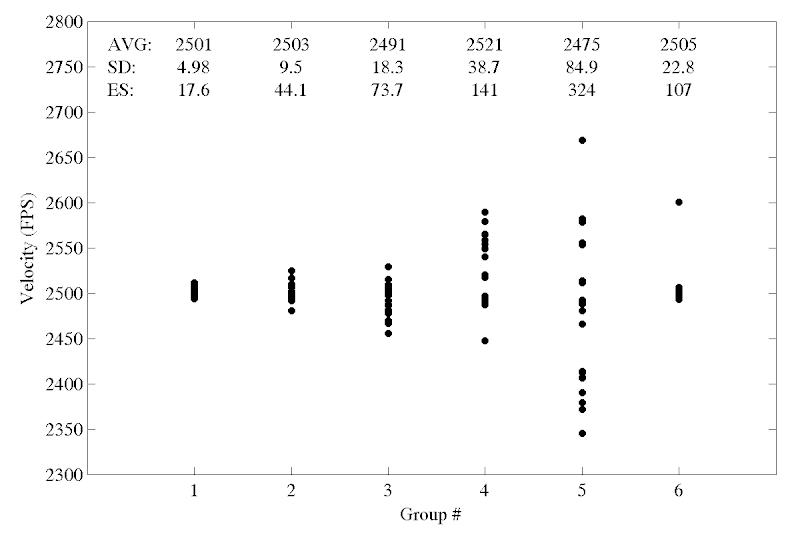
<div class="ubbcode-block"><div class="ubbcode-header">Originally Posted By: himaster</div><div class="ubbcode-body">I don't think SD is worth squat. Here's why:
You could have a couple rounds with 100 fps difference from the mean. If the rest of your rounds were all close in terms of velocity, it would show a small SD.
You also need to know where your chrony ends its first standard deviation. Is it 2/3rds? 3/4ths on the bell curve?
I find extreme spread as the only useful measurement. I want to know from low to high what my spread is. That's how you eliminate flyers.
After all is said and done, if it prints an "X" I don't care what the chrony says. It's a keeper. </div></div>
Here's what one flyer, 100 fps away from average of 2500 fps, does to a 20-shot group with less than 5 fps SD. It increases SD to 23 fps. One or two flyers definitely do have an impact to the computed SD.

Re: Standard deviation
<div class="ubbcode-block"><div class="ubbcode-header">Originally Posted By: PeterN</div><div class="ubbcode-body"> I might add that keeping ES in the single digits is no easy trick </div></div>
Tell us more. ES in single digits is something I've yet to do.
I'm weighing on a redding balance scale. Going to upgrade to a Denver Precision or Acculab soon. Any other thoughts?
What do you feel is the key to single digit ES? I'll be pushing out to 1000 yards soon (currently at 600 and doing about 1 moa.)
<div class="ubbcode-block"><div class="ubbcode-header">Originally Posted By: PeterN</div><div class="ubbcode-body"> I might add that keeping ES in the single digits is no easy trick </div></div>
Tell us more. ES in single digits is something I've yet to do.
I'm weighing on a redding balance scale. Going to upgrade to a Denver Precision or Acculab soon. Any other thoughts?
What do you feel is the key to single digit ES? I'll be pushing out to 1000 yards soon (currently at 600 and doing about 1 moa.)
Re: Standard deviation
<div class="ubbcode-block"><div class="ubbcode-header">Originally Posted By: bricktop</div><div class="ubbcode-body"><div class="ubbcode-block"><div class="ubbcode-header">Originally Posted By: himaster</div><div class="ubbcode-body">I don't think SD is worth squat. Here's why:
You could have a couple rounds with 100 fps difference from the mean. If the rest of your rounds were all close in terms of velocity, it would show a small SD.
You also need to know where your chrony ends its first standard deviation. Is it 2/3rds? 3/4ths on the bell curve?
I find extreme spread as the only useful measurement. I want to know from low to high what my spread is. That's how you eliminate flyers.
After all is said and done, if it prints an "X" I don't care what the chrony says. It's a keeper. </div></div>
Here's what one flyer, 100 fps away from average of 2500 fps, does to a 20-shot group with less than 5 fps SD. It increases SD to 23 fps. One or two flyers definitely do have an impact to the computed SD.
 </div></div>
</div></div>
23 is at the way high end of respectable. In other words, it's not terrible. And that's with a 100 fps flyer thrown it. That's a big flyer. You don't need that big a flyer to drop points at 600 or farther. 50 fps will do it and that takes your SD back to respectable. I stand by what I said.
Good post, though. You definately know what you are talking about and did some work.
<div class="ubbcode-block"><div class="ubbcode-header">Originally Posted By: bricktop</div><div class="ubbcode-body"><div class="ubbcode-block"><div class="ubbcode-header">Originally Posted By: himaster</div><div class="ubbcode-body">I don't think SD is worth squat. Here's why:
You could have a couple rounds with 100 fps difference from the mean. If the rest of your rounds were all close in terms of velocity, it would show a small SD.
You also need to know where your chrony ends its first standard deviation. Is it 2/3rds? 3/4ths on the bell curve?
I find extreme spread as the only useful measurement. I want to know from low to high what my spread is. That's how you eliminate flyers.
After all is said and done, if it prints an "X" I don't care what the chrony says. It's a keeper. </div></div>
Here's what one flyer, 100 fps away from average of 2500 fps, does to a 20-shot group with less than 5 fps SD. It increases SD to 23 fps. One or two flyers definitely do have an impact to the computed SD.

23 is at the way high end of respectable. In other words, it's not terrible. And that's with a 100 fps flyer thrown it. That's a big flyer. You don't need that big a flyer to drop points at 600 or farther. 50 fps will do it and that takes your SD back to respectable. I stand by what I said.
Good post, though. You definately know what you are talking about and did some work.
Re: Standard deviation
Something else to consider...
I usually test loads via ladder test at distance. I have noticed that during the test (which is in tenth of a grain increments) a very close velocity group will emerge.
I just did one two days ago at 600 and the fps would be off by 30 or 40 between tenths. This would cause very large deviations in bullet impact on the target. Then a sort of "group" emerges, both in velocity and confirmed on the target. I had 5 shots that chronied within about 15 fps of each other. These velocities produced a group just under 3 inches on the target. I found my accuracy node.
Now anything 20 fps out of that accuracy node on either side (faster or slower) produced flyers.
Is there a point to all this? Yes. If it weren't for accuracy nodes, extreme spread would not matter that much. Once an accuracy node is determined, extreme spread is everything. 20 fps outside the accuracy node either way will produce flyers.
I suck at explaining things like this. I hope this makes sense.
Something else to consider...
I usually test loads via ladder test at distance. I have noticed that during the test (which is in tenth of a grain increments) a very close velocity group will emerge.
I just did one two days ago at 600 and the fps would be off by 30 or 40 between tenths. This would cause very large deviations in bullet impact on the target. Then a sort of "group" emerges, both in velocity and confirmed on the target. I had 5 shots that chronied within about 15 fps of each other. These velocities produced a group just under 3 inches on the target. I found my accuracy node.
Now anything 20 fps out of that accuracy node on either side (faster or slower) produced flyers.
Is there a point to all this? Yes. If it weren't for accuracy nodes, extreme spread would not matter that much. Once an accuracy node is determined, extreme spread is everything. 20 fps outside the accuracy node either way will produce flyers.
I suck at explaining things like this. I hope this makes sense.
Re: Standard deviation
Relying on memory and graduate level statistics course 35 years ago so if I'm out of line....
In examining statistics concerning central tendancies (mean, standard deviation, standard error, etc.), especially with samples containing small sample sizes (10,20,30)it's a really good idea to do "sensitivity analyses". Bricktop provided a very good example- he jiggered his data set and examined the effect. Another example in our case is to throw out the two extremes, throw out the highest and lowest velocities and rexamine your measure of variability, it should be tighter.
If your mean and standard deviation changes radically with a small change in your data set, you need more samples (velocity measurements)to more accurately estimate your TRUE variability. And, ideally, you would not want to introduce other variables while increasing sample size (hot barrel, very different air temp on a different day, etc.).
I vaguely remember a topic we covered in Stats about "Power Analysis"- you can actually calculate the number of samples (shots) required to detect expected variances if they indeed exist.
Alas, the effects of years of alcohol and dementia end my memories of statistics at that point.
Relying on memory and graduate level statistics course 35 years ago so if I'm out of line....
In examining statistics concerning central tendancies (mean, standard deviation, standard error, etc.), especially with samples containing small sample sizes (10,20,30)it's a really good idea to do "sensitivity analyses". Bricktop provided a very good example- he jiggered his data set and examined the effect. Another example in our case is to throw out the two extremes, throw out the highest and lowest velocities and rexamine your measure of variability, it should be tighter.
If your mean and standard deviation changes radically with a small change in your data set, you need more samples (velocity measurements)to more accurately estimate your TRUE variability. And, ideally, you would not want to introduce other variables while increasing sample size (hot barrel, very different air temp on a different day, etc.).
I vaguely remember a topic we covered in Stats about "Power Analysis"- you can actually calculate the number of samples (shots) required to detect expected variances if they indeed exist.
Alas, the effects of years of alcohol and dementia end my memories of statistics at that point.
Re: Standard deviation
Extreme spread, or to use the more correct term 'range', is not AFAIK considered a valid measurement for *predicting* anything. If you want to know what the range was of a given string of shots, yes, its a perfectly legit measurement. The caveat is that out of any given sample, whether its 3 shots or 300, range only considers *two* - the extreme high and the extreme low values. The ones that are generally considered by definition to be statistical outliers, and the least likely to re-occur, hence the relatively poor ability to *predict* what the values of the next string, or a string 500rds from now, will be. Personally I care very little about what the range of the velocities of the shots I already put down range is... but I do care very much about what the future velocities may be.
Standard deviation itself as an abstract number is hard for most people to calculate by hand, and harder for them to get their minds around. But given a decent sample size, it *will* allow you to reasonably predict what your future range or 'extreme spread' will be. For most statistical analysis, +/- 2 SD or ~95% is considered reasonable. So take your SD x4 (+/- 2) and thats approximately what you can expect to see for a long term extreme spread if you chrono'd every round. If you really want to depress the heck out of yourself, go for the ~99.7% level (+/- 3 SD) and multiply your SD by 6... thats the realm you can reasonably expect any given sample drawn from that population (i.e. ammo loaded to the same standards with those particular components and fired thru that particular barrel) to fall within. It's not pretty, and most people find the warm fuzzy feeling from just calculating simple ES and cherry-picking the one time that the numbers came out the way they wanted to be more reassuring...
Extreme spread, or to use the more correct term 'range', is not AFAIK considered a valid measurement for *predicting* anything. If you want to know what the range was of a given string of shots, yes, its a perfectly legit measurement. The caveat is that out of any given sample, whether its 3 shots or 300, range only considers *two* - the extreme high and the extreme low values. The ones that are generally considered by definition to be statistical outliers, and the least likely to re-occur, hence the relatively poor ability to *predict* what the values of the next string, or a string 500rds from now, will be. Personally I care very little about what the range of the velocities of the shots I already put down range is... but I do care very much about what the future velocities may be.
Standard deviation itself as an abstract number is hard for most people to calculate by hand, and harder for them to get their minds around. But given a decent sample size, it *will* allow you to reasonably predict what your future range or 'extreme spread' will be. For most statistical analysis, +/- 2 SD or ~95% is considered reasonable. So take your SD x4 (+/- 2) and thats approximately what you can expect to see for a long term extreme spread if you chrono'd every round. If you really want to depress the heck out of yourself, go for the ~99.7% level (+/- 3 SD) and multiply your SD by 6... thats the realm you can reasonably expect any given sample drawn from that population (i.e. ammo loaded to the same standards with those particular components and fired thru that particular barrel) to fall within. It's not pretty, and most people find the warm fuzzy feeling from just calculating simple ES and cherry-picking the one time that the numbers came out the way they wanted to be more reassuring...
Re: Standard deviation
Here's one shooter's take on using chronograph data:
http://riflemansjournal.blogspot.com/2010/07/statistics-for-rifle-shooters.html
Here's one shooter's take on using chronograph data:
http://riflemansjournal.blogspot.com/2010/07/statistics-for-rifle-shooters.html
Re: Standard deviation
<div class="ubbcode-block"><div class="ubbcode-header">Originally Posted By: Aimsmall55</div><div class="ubbcode-body">I understand that standard deviation is the measurement of the consistency and reliability for a bullet to travel within a given fps range. My question is what is an acceptable sd for many long range shooters? For instance I shot a 10 shot group with a standard deviation of 9. Is that good? If not what can I do at the reloading bench to improve. </div></div>
For me:
SDs of 20-30: most factory ammo
SDs of 15-20: decent reloaded ammo
SDs of 10-15: doing things pretty well, consistent
SDs of <10: things are very consistent
Chris
<div class="ubbcode-block"><div class="ubbcode-header">Originally Posted By: Aimsmall55</div><div class="ubbcode-body">I understand that standard deviation is the measurement of the consistency and reliability for a bullet to travel within a given fps range. My question is what is an acceptable sd for many long range shooters? For instance I shot a 10 shot group with a standard deviation of 9. Is that good? If not what can I do at the reloading bench to improve. </div></div>
For me:
SDs of 20-30: most factory ammo
SDs of 15-20: decent reloaded ammo
SDs of 10-15: doing things pretty well, consistent
SDs of <10: things are very consistent
Chris
Re: Standard deviation
when dealing with small non-normal distributions, the median is more appropriate to use than the mean.
when dealing with small non-normal distributions, the median is more appropriate to use than the mean.
Re: Standard deviation
Some more data (hopefully someone is finding this useful):
You can see with the 95.4% confidence (22-shot groups), that the average ES/SD is 4, where 95.4% of the data should be within +/- 2 SD (4 SD total). A good way to tell if your data looks right (most all statistics of the natural world relate to the normal distribution), divide your ES by SD. If ES/SD isn't very close to where it should be for your group size (see below), you might have a load issue, in which case it would be helpful to look at the numbers explicitly (maybe a scale zero problem). You can see in group six (where SD of the small group is ~2 fps, but there is a +100fps flyer), the ES/SD is not what it should be for the group size (of course it is hard to tell with small group sizes).
<span style="font-family: 'Courier New'">
.... Spread .... | Confidence Interval
------------------------------------------
+/- sigma (2SD) | 68.3%
+/- 2*sigma (4SD) | 95.4%
+/- 3*sigma (6SD) | 99.7%
+/- 4*sigma (8SD) | 99.994%</span>
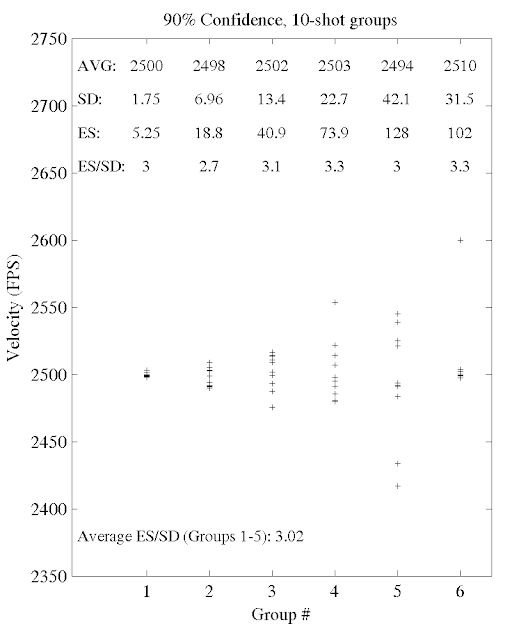
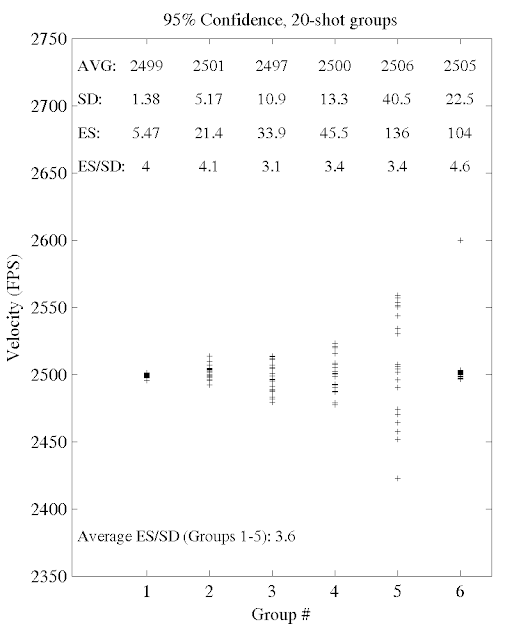
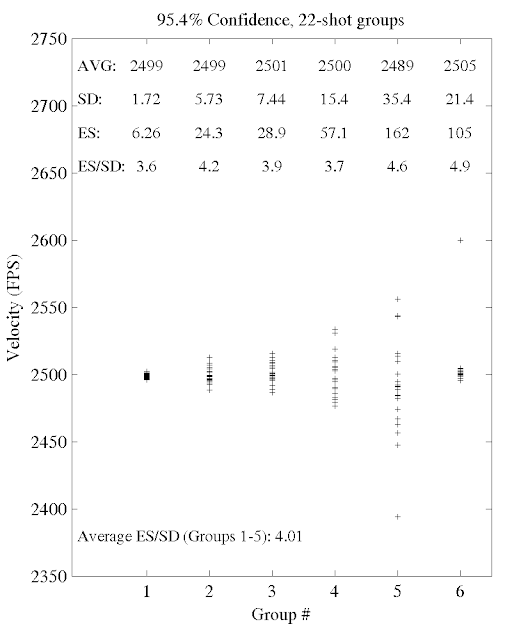
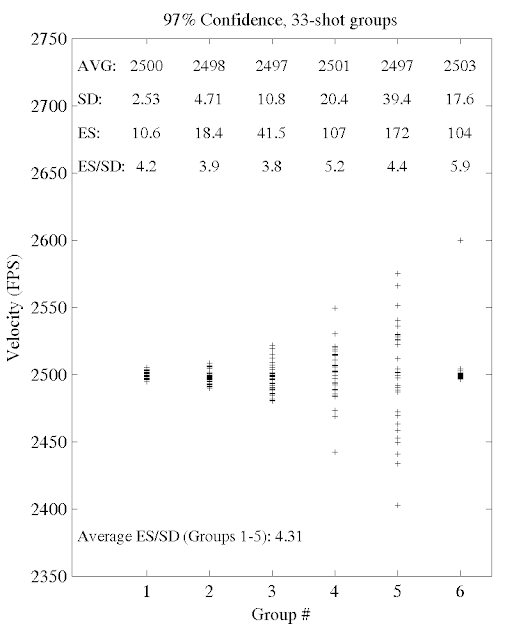
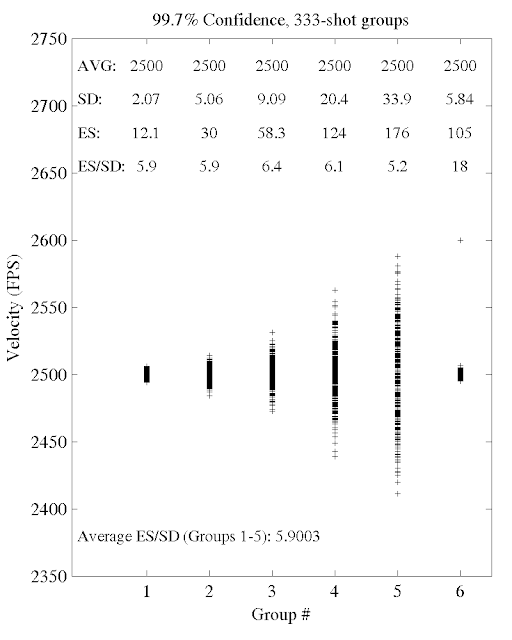
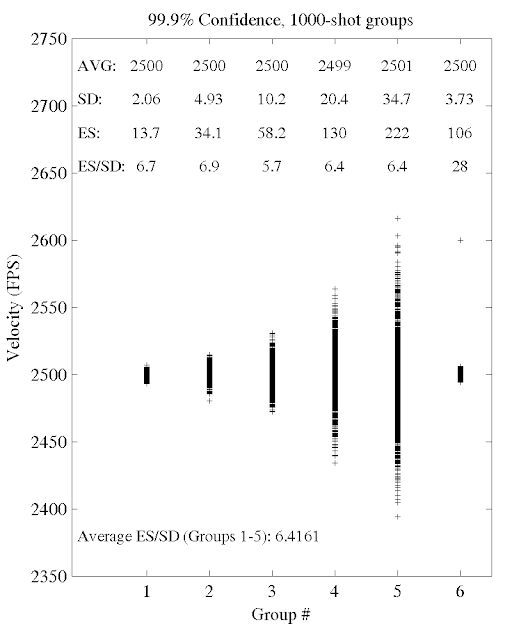
This one says 100%, but it rounded up for formatting, should be 99.99%.
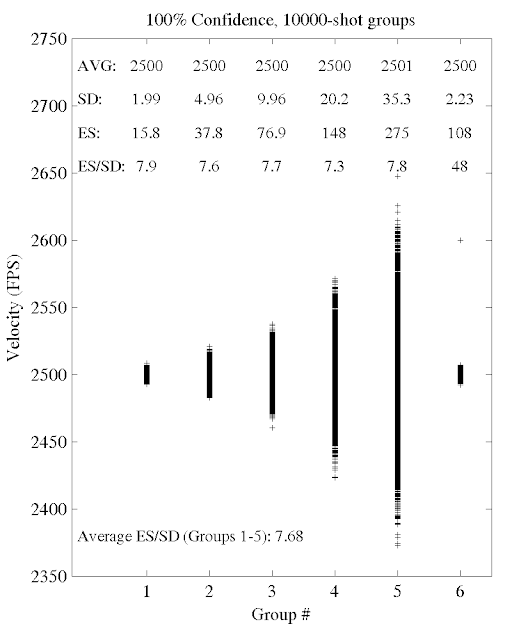
Some more data (hopefully someone is finding this useful):
You can see with the 95.4% confidence (22-shot groups), that the average ES/SD is 4, where 95.4% of the data should be within +/- 2 SD (4 SD total). A good way to tell if your data looks right (most all statistics of the natural world relate to the normal distribution), divide your ES by SD. If ES/SD isn't very close to where it should be for your group size (see below), you might have a load issue, in which case it would be helpful to look at the numbers explicitly (maybe a scale zero problem). You can see in group six (where SD of the small group is ~2 fps, but there is a +100fps flyer), the ES/SD is not what it should be for the group size (of course it is hard to tell with small group sizes).
<span style="font-family: 'Courier New'">
.... Spread .... | Confidence Interval
------------------------------------------
+/- sigma (2SD) | 68.3%
+/- 2*sigma (4SD) | 95.4%
+/- 3*sigma (6SD) | 99.7%
+/- 4*sigma (8SD) | 99.994%</span>






This one says 100%, but it rounded up for formatting, should be 99.99%.

Re: Standard deviation
<div class="ubbcode-block"><div class="ubbcode-header">Originally Posted By: bricktop</div><div class="ubbcode-body">Some more data (hopefully someone is finding this useful):
You can see with the 95.4% confidence (22-shot groups), that the average ES/SD is 4, where 95.4% of the data should be within +/- 2 SD (4 SD total). A good way to tell if your data looks right (most all statistics of the natural world relate to the normal distribution), divide your ES by SD. If ES/SD isn't very close to where it should be for your group size (see below), you might have a load issue, in which case it would be helpful to look at the numbers explicitly (maybe a scale zero problem). You can see in group six (where SD of the small group is ~2 fps, but there is a +100fps flyer), the ES/SD is not what it should be for the group size (of course it is hard to tell with small group sizes).
<span style="font-family: 'Courier New'">
.... Spread .... | Confidence Interval
------------------------------------------
+/- sigma (2SD) | 68.3%
+/- 2*sigma (4SD) | 95.4%
+/- 3*sigma (6SD) | 99.7%
+/- 4*sigma (8SD) | 99.994%</span>






This one says 100%, but it rounded up for formatting, should be 99.99%.

</div></div>
This is a great thread, and I appreciate the participation of all the posters in it. Would someone kindly tell me, as I am new to this end of shooting, what you can do with this data? Am I mistaken to assume that you can essentially say with certainty that every round in this load will shoot within 7.68 FPS of the average?
So this would indicate consistent ammo - how well does this type of ammo group in the rifle? I assume the goal is to keep all things consistent to rule out the factors that "tolerance stack" and contribute poor accuracy.
<div class="ubbcode-block"><div class="ubbcode-header">Originally Posted By: bricktop</div><div class="ubbcode-body">Some more data (hopefully someone is finding this useful):
You can see with the 95.4% confidence (22-shot groups), that the average ES/SD is 4, where 95.4% of the data should be within +/- 2 SD (4 SD total). A good way to tell if your data looks right (most all statistics of the natural world relate to the normal distribution), divide your ES by SD. If ES/SD isn't very close to where it should be for your group size (see below), you might have a load issue, in which case it would be helpful to look at the numbers explicitly (maybe a scale zero problem). You can see in group six (where SD of the small group is ~2 fps, but there is a +100fps flyer), the ES/SD is not what it should be for the group size (of course it is hard to tell with small group sizes).
<span style="font-family: 'Courier New'">
.... Spread .... | Confidence Interval
------------------------------------------
+/- sigma (2SD) | 68.3%
+/- 2*sigma (4SD) | 95.4%
+/- 3*sigma (6SD) | 99.7%
+/- 4*sigma (8SD) | 99.994%</span>






This one says 100%, but it rounded up for formatting, should be 99.99%.

</div></div>
This is a great thread, and I appreciate the participation of all the posters in it. Would someone kindly tell me, as I am new to this end of shooting, what you can do with this data? Am I mistaken to assume that you can essentially say with certainty that every round in this load will shoot within 7.68 FPS of the average?
So this would indicate consistent ammo - how well does this type of ammo group in the rifle? I assume the goal is to keep all things consistent to rule out the factors that "tolerance stack" and contribute poor accuracy.
Re: Standard deviation
After case prep and everything is ready. Do you think that an rcbs digital powder dispenser will give acceptable readings as long as you pay STRICT attention to weights.
After case prep and everything is ready. Do you think that an rcbs digital powder dispenser will give acceptable readings as long as you pay STRICT attention to weights.
Similar threads
- Replies
- 12
- Views
- 435
- Replies
- 29
- Views
- 1K
